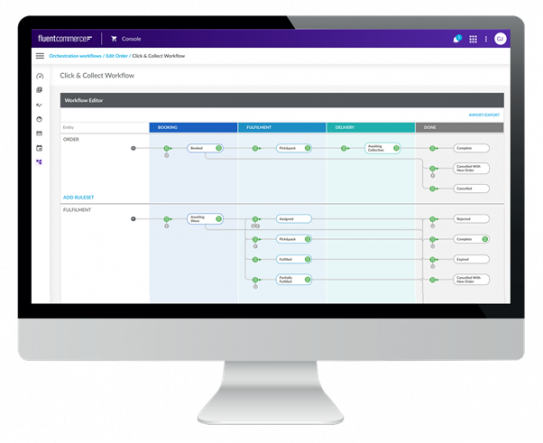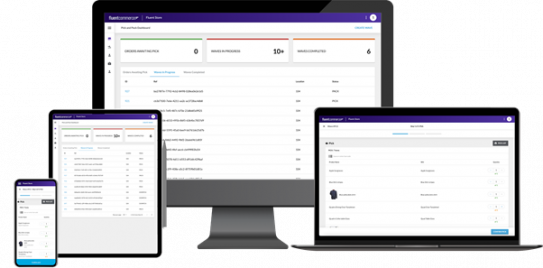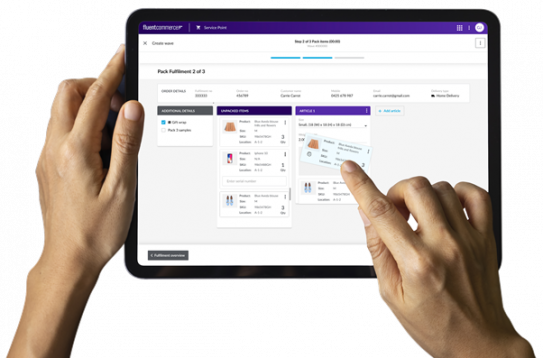
The role of the OMS in omnichannel strategies for retailers and the customer journey
OMSs (Order Management Systems) sit at the heart of commerce operations, at the center of existing systems. They connect different systems (e-commerce sites, PIM systems, payment systems, carriers’ systems, etc.), provide a consolidated view of inventory, and coordinate product availability. In the age of omnichannel retailing, an OMS with a DOM (Distributed Order Management) system helps to optimize the handling of orders and their distribution, a real asset for retailers.
ERP and OMS: Cooperation or Competition?
An ERP system provides an overview of inventory, enabling you as a retailer to predict upcoming purchases so that you can maintain your inventory accordingly. However, it doesn’t give a view of inventory in transit, for example. It provides a snapshot at a specific moment in time. ERP can also handle ‘basic’ order management, in companies whose needs are relatively simple, since one of the main advantages of an ERP system is that it can apply business processes applicable on a company-wide scale.
However, this ‘uniformity’ has a cost; it makes it difficult for any retailer to adapt quickly, or to make adjustments in a short period of time, or even to react to situations on a case-by-case basis. At a time when customer expectations and preferences are changing quickly, and when buying patterns can vary from one region to another, the use of ERP systems alone is quickly becoming outdated and inadequate.
That’s why more and more retailers are adopting an OMS, as well as an ERP system as an accounting system, to track and record data on orders and inventory movement. The OMS takes inventory data provided by the existing systems in your IT environment, such as ERP, e-commerce, warehouse management and point of sale systems, to provide a single, realistic view of inventory availability, enabling days in inventory to be optimized.
All of this leads us to conclude that the two tools complement each other, and it is wrong to pit them against each other.
How Does an OMS Improve the Customer Journey?
The OMS manages the availability of an item on an e-commerce site. As the customer progresses through the ordering process, a promise to the customer is created, starting from the stage of viewing the product information.
The OMS will ensure this customer promise is kept by:
- Providing accurate information
- Ensuring the consistency of this information from the start of the customer journey to the end, including the payment stage and even the delivery stage
In addition, on this same product information page and following the industry-specific rules set by the retailer, the OMS displays a range of information that can help the customer to make informed purchasing decisions and the retailer to better optimize inventory, thereby reducing customer disappointment. This information could include:
- Exact inventory locations,
- Availability in the nearest stores so that the customer can go and collect their purchase,
- The delivery options available and how long each will take: available within 3 hours to Click & Collect in a store or dispatched in the next 24 hours from the central depot, for example.
The OMS then sums up all this information on the shopping cart page to give the customer a comprehensive and precise overview of their order, including the preparation and delivery times; important factors to help them optimize their order and confirm it with confidence.
Increased Visibility into Inventory Levels in Real Time
With an OMS, you have an overall (or unified) view of all inventory. Rather than being divided up, inventory levels (e-commerce site inventory/store inventory/central depot inventory) form a whole, of which you have a real-time overview. This precise view enables you to avoid losing sales, or on the contrary promising items that turn out to be unavailable, and also to prevent stockouts. You’ll be selling better... and more. And you’ll be able to deliver a great customer experience.
This view in real time or as close to it as possible is provided using API calls made regularly between the OMS and the software in your ecosystem - the WMS, ERP system, CRM software, etc.
A Transparent Omnichannel Experience
Thanks to the OMS, the item ordered comes from the optimal location, which is the location that will allow the retailer to maximize their return on investment and minimize transport costs, while at the same time fulfilling the customer's order quickly.
On the customer’s side, as they want a transparent omnichannel experience, the OMS will keep them updated on the progress of their order in real time. As the order fulfillment process goes on, the customer will receive status updates by email, which will have been triggered in the OMS back office.
For example, if they have opted for a Click & Collect order, they will receive an email notification at each stage of their order: when it is being prepared, when it has left the warehouse, when it arrives in the store and when it is ready to be collected.
All of these stages can be set up by the retailer according to their omnichannel strategy, depending on needs and how they change.
From the moment the payment is made, the orchestration and sourcing rules set up by the retailer will come into play. After having checked stock levels across the board, the OMS will make sure that the ordered item is picked in the most appropriate sourcing location. This can mean, for example, fulfilling an order that has been made on the site in the store that has the highest quantity of the item, or in the store with the lowest conversion rate. This selection will then determine the delivery options offered to the customer.
Creating a Sourcing and Shipping Strategy in the OMS
Sourcing and shipping strategies are specific to retailers, who can choose the one that is best suited to their business in the OMS interface. So they can decide to fulfill a certain order in a certain store that is closer to this customer, rather than from the warehouse, which is further away.
In the OMS’s back-office interface, the retailer has a comprehensive dashboard showing the orders made on the e-commerce site. They have a detailed real-time view of each of their orders: content, status, delivery method, customer details, and also how they are going to be fulfilled; for example, part of the order might be prepared in the central depot and then sent to the store, with the rest prepared by the store. This is what we call the sourcing strategy.

It’s the retailer themself who will have configured this strategy, either by selecting it from the library of rules provided by Fluent Commerce or setting up their own orchestration and sourcing rules in advance, according to their own strategy.

Thanks to the real-time visibility into their orders via a dashboard provided by the OMS, the retailer can redefine, polish, and modify their strategy. By extension, it is this same overview that will make it possible to optimize transport costs, since the OMS will send the choice of delivery method and carrier to the TMS (Transport Management System).
Order Management and Customer Service Management with an OMS
The order management process is managed by the OMS once the order is confirmed. It is given a unique tracking reference code, which will be used by all the existing software in the ecosystem. It’s the orchestration of the rules set up in the OMS by the retailer that will determine if the order can be fulfilled by the central depot or by a store before it is picked and packed by a warehouse worker or sales assistant.

The OMS can optimize this process by facilitating the stages employees must go through. At each of these stages, the order status is updated in real time in the OMS interface. With the Fluent Commerce solution, customer service staff have the choice between using the same interface as the retailer’s back-office staff, and using the solution integrated with Salesforce Service Cloud, which the OMS will communicate to via regular API calls to give it the same information.
The advantage of a single interface is simplifying omnichannel returns, for example online purchases returned in-store. The staff member in contact with a customer who is disappointed by an item will have full visibility into their order, as well into the availability of other items that could replace the unsatisfactory item. This will help them to react quickly before thinking about canceling and refunding the order since they will be able to act on the order and modify it in real time, over the phone.
In a worst-case scenario, the staff member will be able to refund the order through the same interface, which optimizes their work, making it much more efficient. The quick reactivity enabled by an optimal interface can give a customer who was initially disappointed by an item an impression of efficiency and competence.
Conclusion
The clarification of all of these processes makes it clear to see that an OMS has a central role in an optimal order process; a role which is not likely to go away in 2022, after the huge disruption caused to supply chains by the pandemic. Many retailers have found themselves unable to deliver on orders because they couldn’t obtain the stock, which is why it is so important to be extremely transparent in customer promises, and in the information given to consumers about delivery. With visibility into inventory in real time, they will know exactly where the available products are, so that they can provide accurate information to customers.
To be able to demonstrate agility and satisfy more and more exacting customer expectations, the most foresighted retailers would be wise to implement robust and long-term omnichannel strategies. That is where an OMS (Order Management System) will play all the more of a crucial role given that an omnichannel service approach is a pivotal factor in the customer experience. Something that has become and will continue to become more and more mobile, both physically and virtually if we look at the future immersive world of the metaverse that Mark Zuckerberg is building for us.
Article written in collaboration with Fluent Commerce